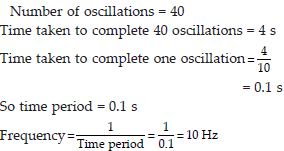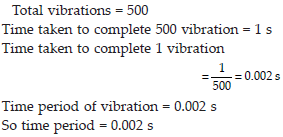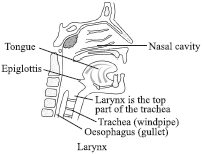Sound (Physics) Class 8 - NCERT Questions
Choose the correct answer.
Sound can travel through
(A) gases only (B) solids only
(C) liquids only
(D) solids, liquids and gases.
(D) Solids, liquids and gases
Q 2.Voice of which of the following is likely to have minimum frequency?
(A) Baby girl (B) Baby boy
(C) A man (D) A woman
(A) Baby girl
Q 3.In the following statements, tick ‘T’ against those which are true, and ‘F’ against those which are false.
(A) Sound cannot travel in vacuum.
(B) The number of oscillations per second of a vibrating object is called its time period.
(C) If the amplitude of vibration is large, sound is feeble.
(D) For human ears, the audible range is 20 Hz to 20, 000 Hz.
(E) Lower the frequency of vibration,higher is the pitch.
(F) Unwanted or unpleasant sound is termed as music.
(g) Noise pollution may cause partial hearing impairment.
(A) True (B) False
(C) False (D) True
(E) False (F) False
(g) True
Fill in the blanks with suitable words.
(A) Time taken by an object to complete one oscillation is called ______.
(B) Loudness is determined by the ______ of vibration.
(C) The unit of frequency is _______.
(D) Unwanted sound is called ________.
(E) Shrillness of a sound is determined by the _____ of vibration.
(A) time period (B) amplitude
(C) hertz (D) noise
(E) frequency
A pendulum oscillates 40 times in 4 seconds. Find its time period and frequency.
SOLUTION: 
The sound from the mosquito is produced when it vibrates its wings at an average rate of 500 vibrations per second. What is the time period of the vibration ?
SOLUTION: 
Identify the part which vibrates to produce sound in the following instruments.
(A) Dholak (B) Sitar
(C) Flute
(A) Stretched membrane
(B) Strings (C) Air column
What is the difference between noise and music? Can music become noise sometimes?
SOLUTION:The sound which is unpleasant for our ears is called noise. Music is the sound which is pleasant for our ears and has soothing effect. Music becomes noise sometimes when it crosses the bearable range of sound for our ears.
Q 9.List sources of noise pollution in your surroundings.
SOLUTION:There are various sources which cause sound pollution in our surroundings, for example, loud sound of T.V., radio, loud sound of machines in factories, loud musics in parties and honking of horns etc.
Q 10.Explain in what way noise pollution is harmful to humans.
SOLUTION:There are many harmful effects of noise pollution. They are as follows.
(i) Noise pollution can cause temporary or permanent deafening.
(ii) Noise pollution can cause many health related problems like headache, high blood pressure etc.
(iii) It can cause mental illness due to lack of sleep.
Your parents are going to buy a house. They have been offered one on the roadside and another three lanes away from the roadside. Which house would you suggest your parents should buy? Explain your answer.
SOLUTION:I would suggest my parents to buy house three lanes away from the roadside because area away from the roadside have less traffic and thus less noise pollution. This would safe guard our health and peace of mind.
Q 12.Sketch larynx and explain its function in your own words.
SOLUTION:Larynx is the top part of the trachea. It is also called the voice box. The larynx contains the vocal cords. These are V shaped ridges of muscle tissue on the inside lining of the larynx. They vibrate when air passes between them too produce speech.
When you breathe in, air passes in to the larynx and down the trachea towards the lungs. When you swallow, the larynx moves upwards slightly and a flap of cartilage tissue at the back of the tongue called epiglottis closes over the entrance to the larynx. This ensures that food or drink go down the oesophagus (gullet) and not down the trachea.

Lightning and thunder take place in the sky at the same time and at the same distance from us. Lightning is seen earlier and thunder is heard latter. Can you explain why?
SOLUTION:Lightning and thundering take place in the sky at same time and at the same distance from us but lightning is seen earlier than thunder is heard because the speed of light is much greater than that of sound so it reaches us before the sound does.